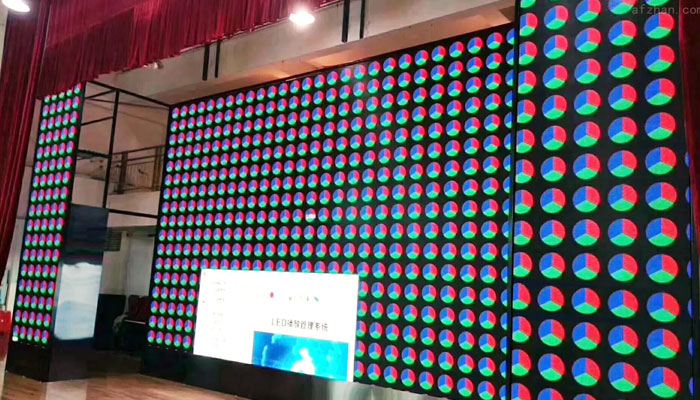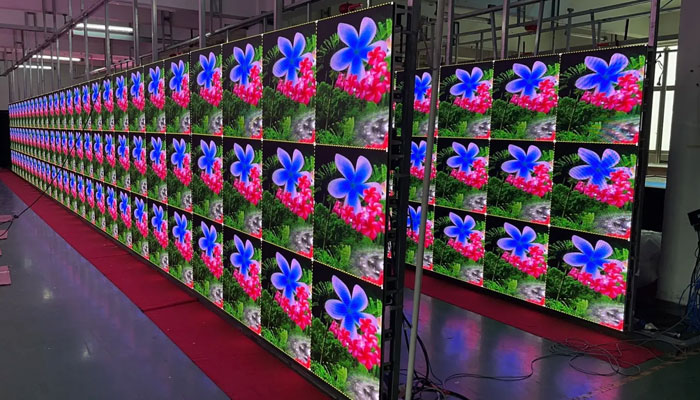In the display industry, LED and LCD are two important technologies that cannot be ignored when selecting a display screen. They almost cover the display needs of the high, medium, and low-end markets.
What are they? What are their respective characteristics and advantages? Read this article to learn about the differences between LCD and LED.
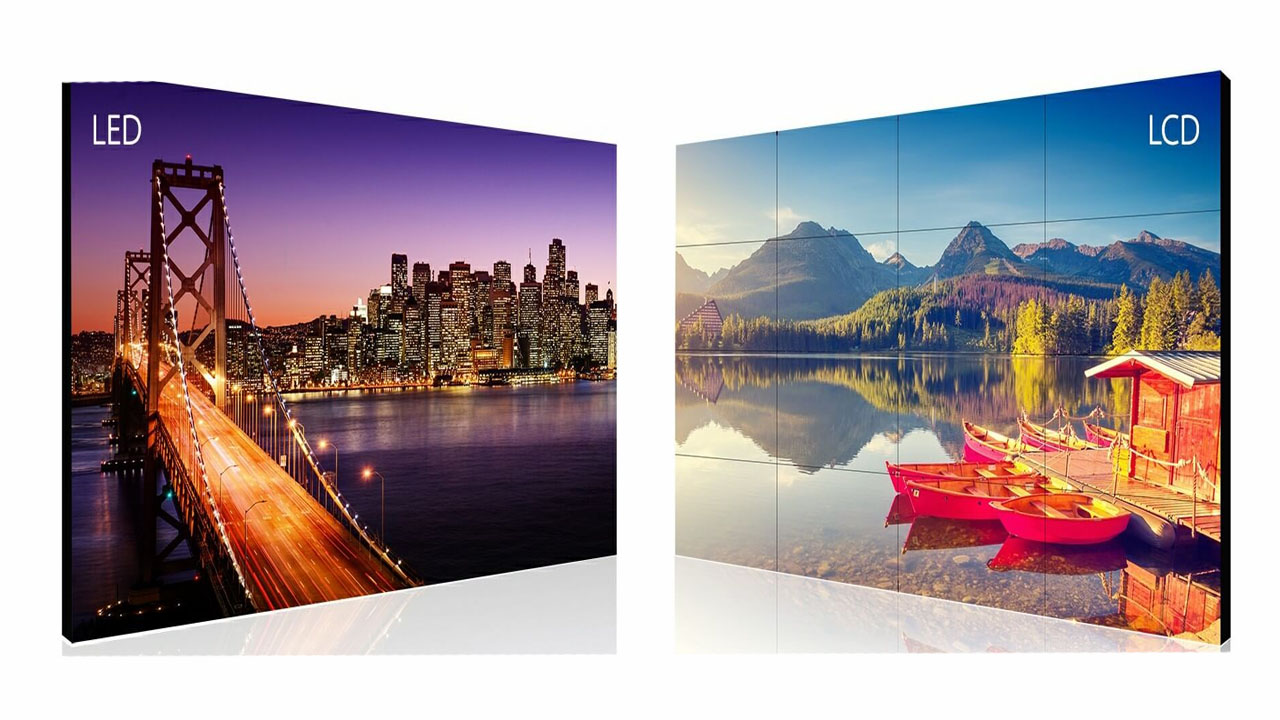
What is LCD?
LCD refers to a flat-panel display technology that combines backlighting technology with a twisted array of liquid crystal layers to form an image. LCDs cannot emit light on their own; they rely on a backlight layer as their light source. The crystals in the liquid crystal layer can flow, but maintain a solid-state structure.
Currently, LCDs primarily use CCFL (cold cathode fluorescent lamps) and LED (light-emitting diodes) as backlight layer light sources. The light emitted by the backlight layer passes through the liquid crystal layer, where it is altered, and ultimately illuminates the target pixels on the pixel panel according to requirements, achieving the purpose of display imaging.
What is LED?
LED is a technology that uses semiconductor materials to emit light through electrical conduction. These semiconductor materials are referred to as light-emitting diodes.
Within a diode, only electrons and holes exist. When current flows through, electrons in the semiconductor band undergo transitions and recombine with holes in the outer orbit, releasing a large amount of energy. A small portion of this energy is released as thermal energy, while the majority is released as photons, thereby achieving the purpose of lighting or image display.
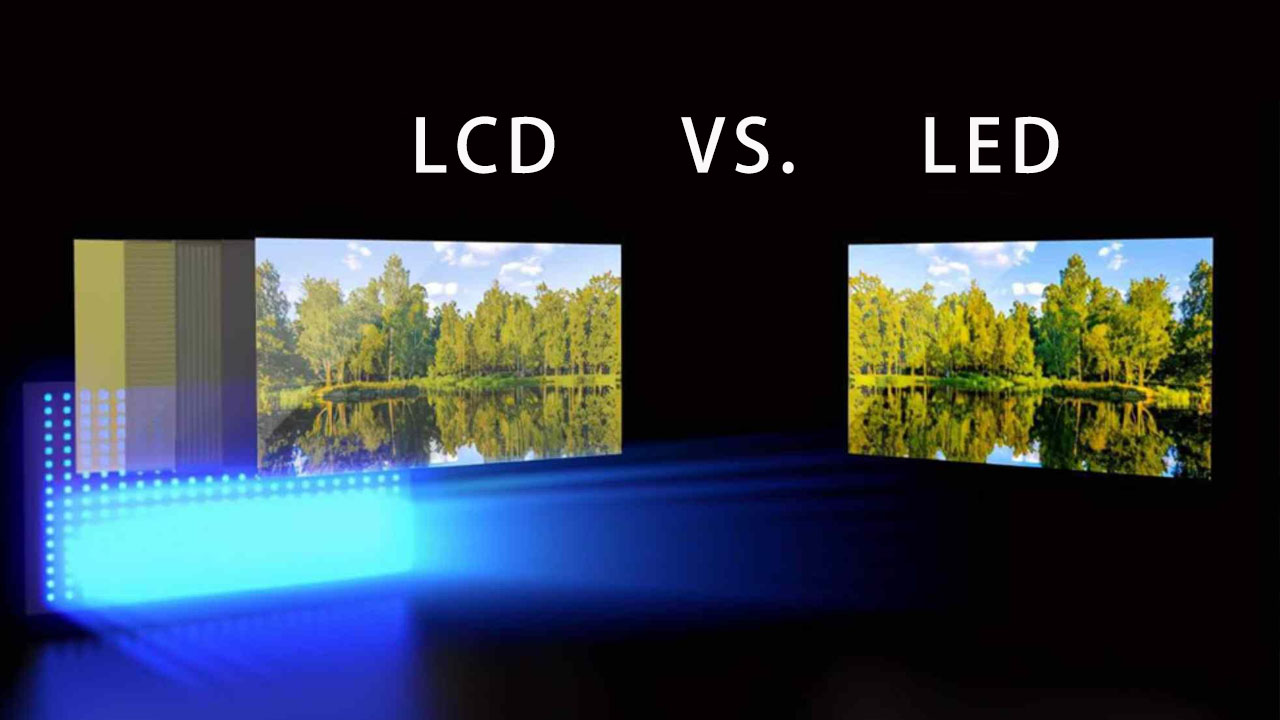
LED vs. LCD
Light-Emitting Technology
LED: LED emits light through the conduction of its own diode, utilizing the principle of photons transitioning from a high-energy state to a low-energy state to produce photons, thereby achieving self-emission. It belongs to self-emitting technology.
Whether used as lighting fixtures or LED displays, LEDs emit light directly without any obstructing layers, resulting in high brightness.
LCD: LCD is a non-self-emitting technology that uses LED or CCFL light as its backlight source. The light from LCD passes through a liquid crystal layer and polarizing filters, altering and blocking the light, resulting in significantly lower brightness compared to LED.
Origin and Evolution
LED: In 1962, LEDs were first invented by scientists. Initially, LEDs could only emit a single red light and were used as simple device indicator lights.
Through technological advancements, LED bulbs became brighter and capable of emitting other colors, while production costs gradually decreased. LEDs began to be widely adopted for everyday lighting and as LED displays.
LCD: LCD was developed in a laboratory in 1968 and was initially used for displays in pocket watches and small calculators. By the 1980s to 1990s, televisions and computers began to be widely adopted and used, and LCD was widely used as a display for televisions and computers.
Physical Structure
LED: The physical structure of an LED primarily consists of a substrate layer, an active layer, an N-type layer, and a P-type layer.
The substrate layer is made of sapphire, silicon, or other materials and typically emits blue light. By coating the substrate layer with a colored material, green and red light can be emitted, forming the three primary colors required for LED display imaging.
The N-type layer contains negative electrons, while the P-type layer contains positive electrons and holes.
The active layer is where electrons from the N-type layer and holes from the P-type layer combine to produce light energy when current flows through them.
LCD: The physical structure of an LCD primarily consists of a backlight, diffuser, thin-film transistor, liquid crystal layer, and polarizing filter.
The backlight uses LED lights or CCFL as the light source, thin-film transistors control the voltage of the pixels, the liquid crystal layer controls the direction of light as it passes through, and the polarizing filter controls the brightness of the light as it passes through.
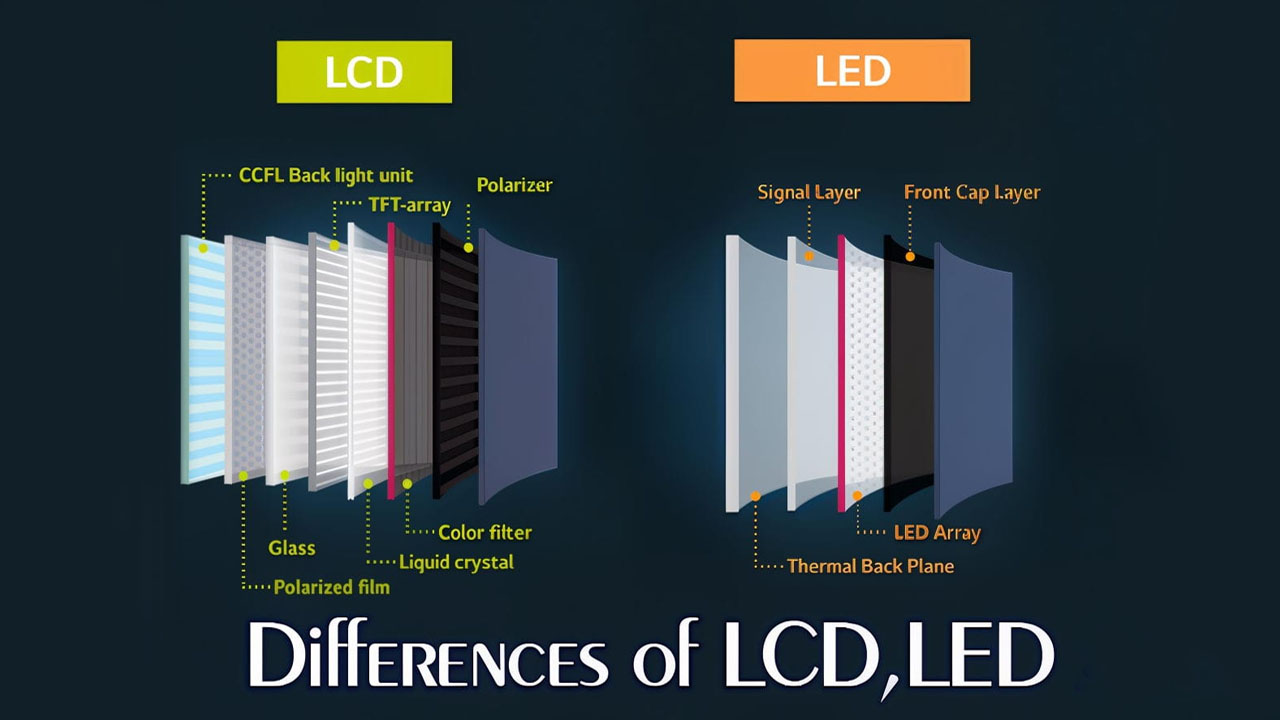
Image quality applied to displays
LED: Since LEDs are self-emitting light sources with no obstruction to the light, their screens have higher brightness and more prominent pixels.
Additionally, the driver IC inside an LED display can independently control each LED to emit light precisely, adjusting their brightness and color. As a result, LED displays have a very wide color gamut, producing bright, vibrant, and lifelike images.
LCD: The backlight of an LCD must pass through a liquid crystal twisting layer and a polarizing filter, which reduces some of the brightness, so its screen brightness is not as high as that of an LED display. Additionally, images that pass through the liquid crystal twisting layer have a narrow viewing angle, so LCDs are only suitable for viewing from the front. When viewed from the side, distorted or distorted images may be visible.
Lifespan
LED: Light-emitting diodes (LEDs) are widely recognized in the industry as a stable and long-lasting light-emitting material. The lifespan of LEDs can exceed 100,000 hours.
LCD: The liquid crystal distortion layer in LCDs undergoes constant movement and change, leading to wear and tear over time. This can result in backlight leakage, severely affecting the viewing experience. Generally, the lifespan of LCDs exceeds 50,000 hours.
Cost
LED: LED production processes are more intricate and complex, and the driver ICs they use can adjust the brightness and color of LED lamp beads at multiple levels.
Additionally, LEDs support customization for various sizes or specifications, and the wide range of options results in higher production costs, making LEDs more expensive than LCDs.
LCD: LCDs typically have fixed sizes during production, their production processes are simpler, and their raw material costs are lower. However, LCDs offer fewer options for adjusting the display afterward. Overall, LCD production costs are lower than those of LED.
Energy Efficiency
LED: The principle of LED lighting is to convert electrical energy into light energy, with an energy conversion efficiency of 60% to 90%, resulting in extremely high energy utilization. Additionally, LED brightness adjustment ranges are broader, allowing energy savings through brightness adjustment during actual use.
LCD: If LCD uses CCFL (cold cathode fluorescent lamps) as the backlight layer, its electrical-to-light conversion efficiency can only reach 10% to 50%, resulting in lower energy conversion efficiency.
Even when using LED as the backlight layer, the backlight structure can cause unnecessary energy loss, as the backlight layer may continue to emit light even when the LCD appears to be off from the outside.
Environmental Friendliness
LED: The production materials for LEDs are environmentally friendly and non-toxic to humans, and most are recyclable for secondary use, causing minimal environmental impact.
LCD: In the past, when LCDs used CCFL (cold cathode fluorescent lamps) as backlight sources, they required mercury, a substance harmful to both the environment and human health. This is why CCFLs have gradually been replaced by LEDs in LCD backlighting.
Applications
LED: LEDs are widely used in lighting fixtures, equipment indicator lights, traffic signals, text signs, and various large-scale indoor and outdoor display screens. LEDs are widely adopted in the lighting and display industries due to their highly customizable performance, high brightness, and low energy consumption.
LCD: LCDs are primarily used in televisions, computer monitors, watch screens, and computer screens. Due to their lower brightness, LCDs are not suitable for outdoor use and are mainly used for indoor displays.
LCDs are cost-effective with average display performance, making them highly popular in the mid-to-low-end display industry.
Conclusion
LCDs hold a market position due to their low cost. LED technology, while more complex and costly, offers significantly superior lighting and display performance compared to LCDs.
Additionally, from a long-term investment perspective, LED has a lifespan approximately twice that of LCD, and it is brighter and more energy-efficient, helping you save more on electricity costs over the long term.


